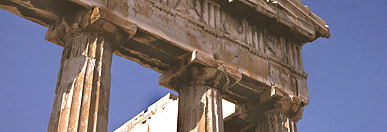
Art and Architecture
Architecture

One of the most instantly recognizable symbols of Greek artistic achievement is its graceful architecture; in particular, the elegant stone columns and triangular carved pediments of the three architectural ‘orders’ developed between 600BC and 300BC.
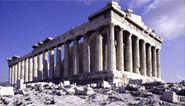 |
| The Parthenon, Athens Acropolis, the best surviving example of a Doric temple. |
These styles were created for building temples to the gods. Carved in marble, they mimic the woodcutting techniques used to build the original wooden buildings.
The Doric order is both the oldest and the simplest, with sturdy columns and pediments covered in sculpture, which, at the time, would have been painted red or blue for impact. The best surviving example of a Doric temple is the Parthenon (438BC) on Athens’ Acropolis.
The Ionic order flourished around the same time in the wealthy cities of Asia Minor. It is lighter and more decorative, with slender columns featuring scrolling curls at each corner of the capital. The style peaked in the now-lost Temple of Artemis at Ephesus, one of the Seven Wonders of the Ancient World. Today, we can see Ionic architecture in the Temple of Athena Nike on the Acropolis.
By the 400sBC a new, more elaborate version of Ionic architecture had emerged – the Corinthian order. It features intricately carved acanthus leaves at the heads of columns that may reflect Middle Eastern influence. The grandeur of the Corinthian order made it a favorite building style in Imperial Rome.
Homes
In ancient Greece, poor people and rich people lived
in different kinds of houses. All houses were made of mud bricks and needed
frequent repairs. Houses of the poor people were very simple compared to the
houses of the rich, which had more rooms centered around a courtyard. Click
to view a typical
rich man's house.
The floors and walls in the houses were carefully created using stones,
tiles, or pebbles. The nicest houses used pebbles to create mosaics. To do
this, they went to the seashore and collected colored pebbles of similar
sizes and arranged them in sand to make a picture or pattern on the floors
or walls.
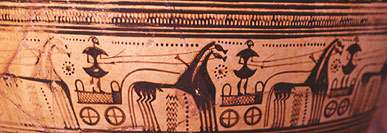
Pottery
Pottery provides a hugely important link to the past, thanks to its durability and widespread use. Decorative amphora, mixing bowls, drinking cups and oil flasks are the best surviving medium for Greek painting, while the distribution of potsherds provides a record of ancient trade routes.
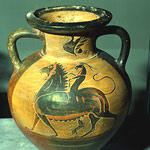 |
| Chimera - a mythical creature on a Greek vase painting. |
Chimera - a mythical creature on a Greek vase painting. Pottery painting began to come of age during the Geometric period of the 8th and 9th centuries BC. Its distinctive Greek key patterns, abstract designs and stick figures were very popular. More popular still was the Corinthian style of the 5th and 6th centuries BC. The black Geometric stick figures were replaced with lively and colorful scenes of people and animals, broken up with floral decorations, probably inspired by Middle Eastern art.
Corinthian pottery was finally ousted from market domination by Athenian Black Figure (and later Red Figure) work of same time. Decorative designs were dropped in favor of scenes from myth or daily life, with finely incised details giving added depth and realism.
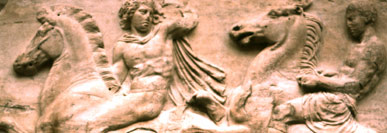
Sculpture
The sculptors of Ancient Greece could portray the human body perfectly in stone and bronze. Whether carving self-standing statues for temples or intricate bas-relief work to adorn architecture, the work of the Classical era was so good, it was unsurpassed until the Italian Renaissance.
Early sculpture was stiff, although sculptors such as Polyclitus perfected the proportions of the male standing figure. By the mid 400sBC, sculptures of gods and heroes on the Temple of Zeus at Olympia and on the Parthenon display more movement and emotion.
A revolution came around 400BC when the new technique of metal casting allowed sculptors to make hollow bronze figures, with more finely honed musculature, hair and clothing than solid metal had allowed.
Surprisingly, sculpture was brightly painted to make it stand out at a distance. Very little original Greek sculpture survives, although we know it from later Roman copies.